#gran chaco
Photo
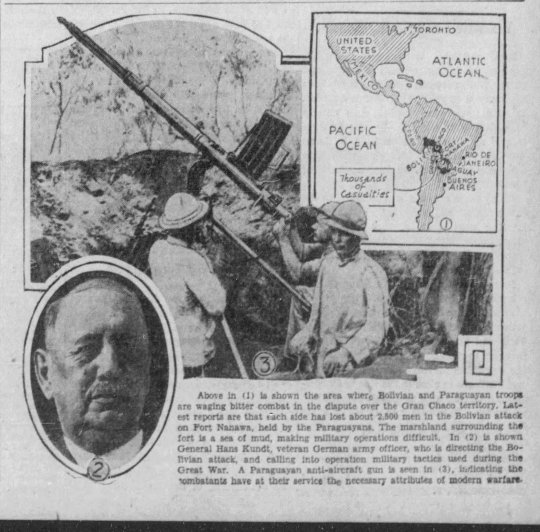
“Above in (1) to shown the area where Bolivian and Paraguayan troops are waging bitter combat in the dispute over the Gran Chaco territory. Latest reports are that each side has lost about 2,000 men in the Bolivian attack on Fort Nanawa, held by the Paraguayans. The marshland surrounding the fort is a sea of mud making military operations difficult. In (2) is shown General Hans Kundt, veteran German army officer, who is directing the Bolivian attack and calling into operation military tactics used during the Great War. A Paraguayan anti-aircraft gun is seen in (1) indicating the combatants have at their service the necessary attributes of modern warfare.”
- from the Kingston Whig-Standard. January 30, 1933. Page 3.
#gran chaco#chaco war#guerra del chaco#paraguay#bolivia#paraguayan history#bolivian history#fort nanawa#german military advisor#world war 1#interwar period#ejército paraguayo#antiaircraft guns#aa guns#cháko Ñorairõ
4 notes
·
View notes
Text
Bosque Vinalito: Modelo de conservación y desarrollo sostenible en Jujuy
Bosque Vinalito: Modelo de conservación y desarrollo sostenible en Jujuy
El proyecto Bosque Vinalito, en Jujuy, busca preservar el bosque nativo y promover el desarrollo socioeconómico, abordando la deforestación y el cambio climático con soluciones sostenibles e inclusivas.
El proyecto Bosque Vinalito, en Jujuy, busca preservar el bosque nativo y promover el desarrollo socioeconómico, abordando la deforestación y el cambio climático con soluciones sostenibles e inclusivas.
El Bosque Vinalito, ubicado en la localidad de Vinalito, en la provincia de Jujuy, es un proyecto de conservación que se destaca por su enfoque integral en la protección de los bosques nativos y…
#ACDI#Asociación Cultural para el Desarrollo Integral#Bosque Vinalito#bosques nativos#carbono#CO2#Cooperativa Fraile Pintado#deforestación#degradación ambiental#Desarrollo Social#desastres naturales#empleos verdes#Especies Nativas#explotación agrícola#extracción forestal#Fraile Pintado#frontera agropecuaria#Gases de Efecto Invernadero#Gran Chaco#Jujuy#medio ambiente#Objetivos de Desarrollo Sostenible#ODS#riesgos climáticos#SbN#servicios ambientales#sobrepastoreo ganadero#soluciones basadas en la naturaleza#Vinalito
0 notes
Text
Se ultiman los detalles de la nueva Terminal de Buses de Yacuiba
El presidente del Comité Cívico de Yacuiba, Henry Medrano, informó que la construcción de la nueva Terminal de Buses de Yacuiba está en su etapa final, con un avance físico del 90%. Se están realizando trabajos para la apertura de la vía de acceso desde la ruta 9, que ahora es doble vía. Se espera que la obra sea entregada en agosto, para el aniversario de la Región Autónoma del Gran Chaco.…

View On WordPress
#aniversario#Avance#Doble Vía#empresa adjudicada.#entrega#Gran Chaco#proyectos viales#seguimiento.#Terminal de Buses#tramo Choere-Acheral#vía de acceso#Yacuiba
0 notes
Text
La locura de la soja en Argetina
Gran Chaco, una pequeña selva tropical en América del Sur, no es la más popular o conocida. En comparación con su selva tropical vecina, la Amazonía, Gran Chacao ocupa el segundo lugar en biodiversidad. A diferencia de la exuberante Amazonía, Gran Chacao carece significativamente de vegetación y es menos colorido en general debido a su falta de humedad.
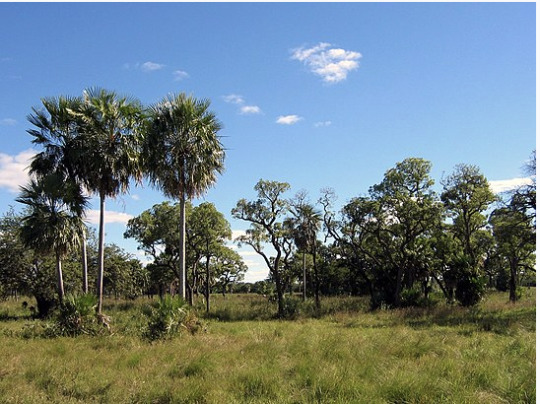
Una imagen de Gran Chaco
Sin embargo, esto no debería impedirnos darle al bosque la atención necesaria para seguir prosperando. Al igual que la Amazonía, Gran Chaco ha sufrido mucha deforestación debido a prácticas agrícolas dañinas en los últimos años. Si bien Gran Chaco carece del gran nombre y la biodiversidad de la Amazonía, sigue siendo el hogar de muchas especies y se extiende por más de 650.000 kilómetros cuadrados. Sin embargo, gran parte de esta tierra está empezando a ser reemplazada por prácticas agrícolas nocivas. Las observaciones de los satélites de Lansat han demostrado que más del 20 por ciento de esta tierra se ha convertido en tierras de cultivo o de pastoreo desde 1985 hasta 1920. Luego, de 2010 a 2018, más de 29.000 kilómetros cuadrados del Gran Chaco fueron talados para fincas y ranchos, y gran parte de la limpieza tuvo lugar en Argentina.

Esta imagen demuestra dos picturas que compara el bosque en el 2000 de diciembre (izquierda) y el bosque en el 2019 de diciembre (derecha). De las imagenes, nosotros podemos ver cómo el bosque pasó de ser tierra despejada a tierras de cultivo.
Además, el veinte por ciento del Gran Chaco argentino ha estado libre de agricultura. Ya sea agrícola o ganadera, el Gran Chaco ha estado libre de ella desde hace veinte años. El clima inestable también ha afectado en gran medida la rápida deforestación, la degradación del suelo y la pérdida de biodiversidad. La actual demanda de alimentos seguirá presionando los principales frentes agrícolas de América del Sur, particularmente para cultivos como la soja y la carne vacuna. Si bien el TNC continúa considerando al Gran Chaco como uno de los lugares más emblemáticos de América Latina y un paisaje alimentario global, debemos poner más cuidado que nunca para ayudar a preservar este espacio. Debemos desarrollar estrategias para aumentar la eficiencia, reducir los impactos negativos y ampliar la visibilidad, manteniendo al mismo tiempo en mente los objetivos ambientales y de desarrollo nacionales.
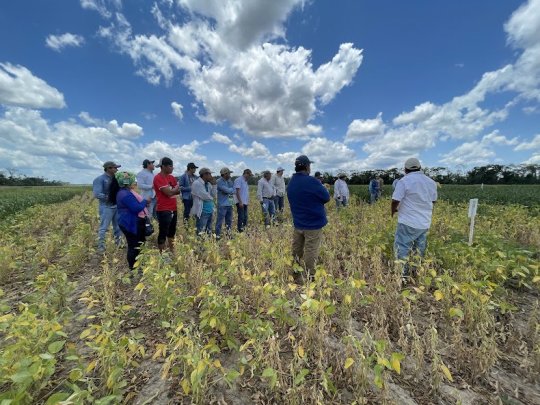
Aún más, se nos ha advertido constantemente sobre cómo seguimos produciendo alimentos, ya que ha contribuido significativamente al cambio climático y la pérdida de biodiversidad. Las malas prácticas en la agricultura son responsables de una cuarta parte de las emisiones de gases de efecto invernadero, el 70 por ciento del uso de agua dulce y el 8 por ciento de la pérdida de hábitat en todo el mundo. Debido a esto, el TNC ha creado un Sistema Alimentario Regenerativo. Esta estrategia promoverá prácticas, métodos y políticas con base científica que apoyen la restauración de la tierra, la protección del agua y el aumento de la biodiversidad en áreas de producción de alimentos como el Gran Chaco.
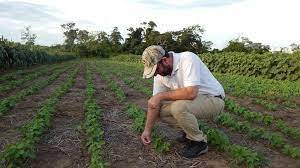
En Argentina, gran parte del bosque se ha convertido en tierras de cultivo para el cultivo de soja y la cría de ganado. Dado que Argentina es el tercer mayor productor de soja, la investigación ha demostrado que la producción de soja ha sido el factor principal en esta deforestación en la década de 2000 A medida que los productores de soja querían obtener más beneficios, se vieron obligados a alcanzar “recursos no explotados” a medida que aumentaba la demanda de soja. Controlar las tasas de deforestación, específicamente en Argentina, ha sido excepcionalmente difícil. En 2007, el gobierno argentino promulgó la “ley forestal” que obliga a los gobiernos locales a minimizar la cantidad de agricultura a gran escala para proteger estos bosques, sin embargo, los estudios han demostrado que estas prácticas son increíblemente infructuosas.
Fuentes:
Imagen 1:
Imagen 2:
Otras Cosas:
youtube
youtube
0 notes
Text
esús Gira desmiente participación en acto político
El presidente del Comité Pro Intereses de Tarija, Jesús Gira, desmintió enfáticamente que hubiera participado alguna vez en alguna proclamación política en Yacuiba, tras cumplir una agenda social en homenaje a los 147 años de la provincia Gran Chaco. El titular cívico señaló que, aun teniendo amistad con el senador Rodrigo Paz Pereira, conociendo y fomentando proyectos y acciones en beneficio de…

View On WordPress
0 notes
Text
GEE WHO WOULD HAVE THOUGHT THAT DEFORESTING THE SECOND AND THIRD LARGEST FORESTS OF SOUTH AMERICA TO PLANT FUCKING SOY WOULD HAVE ENDED UP IN DROUGHT AND CHANGING WEATHER PATTERNS IT'S ALMOST AS IF FORESTS ARE ACTIVE ELEMENTS ON THE WATER CYCLE AND THEIR REMOVAL IS ACTUALLY CHANGING THE CLIMATE IN A CONTINENTAL SCALE CHISPAS CARACOLES REPÁMPANOS DIABLOS RECORCHOLIS RAYOS Y CENTELLAS Y LA REPUTÍSIMA MADRE QUE LO RE PARIÓ
#cosas mias#(third forest in South America is the Mata Atlántica which is virtually gone)#(second is the Gran Chaco that if things go like they are it's gonna dissapear)#(first is the Amazon which isn't doing so good either)
45 notes
·
View notes
Text
Indigenous Peoples living in Isolation in Amazonia and the Gran Chaco regions: "No-contact" policies to protect their lives, territories and self-determination (UNPFII Side Event).
Indigenous Peoples living in Isolation in Amazonia and the Gran Chaco regions: "No-contact" policies to protect their lives, territories and self-determination (UNPFII Side Event).
Watch the Indigenous Peoples living in Isolation in Amazonia and the Gran Chaco regions: "No-contact" policies to protect their lives, territories and self-determination (UNPFII Side Event)
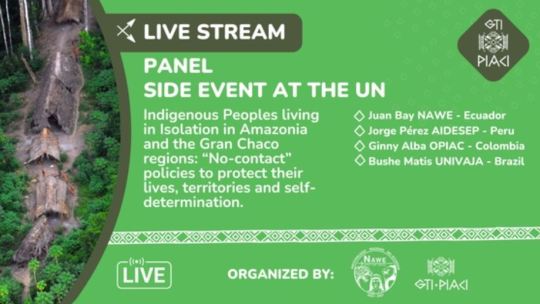
#no-contact#Gran Chaco regions#isolation#indigenous communities#tribal groups#right to self determination#NAWE -Ecuador#AIDESEP-Peru#OPIAC - colombia#UNIVAJA-Brazil#amazon forest#amazonian#Policies to protect#side-events#permanent forum on indigenous issues#unfpii23#united nations headquarters
0 notes
Text
Are you guys familiar with the Gran Chaco War? If not: It was a war between Paraguay and Bolivia, competing for the control of the northern half of Paraguay. The interesting part about it is: Bolivia was a lot stronger than Paraguay, so they should have won the war in about five minutes, but they made so stupid decisions that they kept on ruining every advantage they had. Paraguay, meanwhile, could have easily won the war if they had taken advantage of the Bolivian mistakes, but always failed to do so. In the end, there were thousands of totally avoidable deaths because both sides were lead by idiots. It could have been hilarious if it hadn't been so tragic.
What I'm trying to say: Hotd season two makes me think of the Gran Chaco War a lot.
Edit: this is not a critique of the Hotd writing by the way, since "a bunch of idiots in charge of a whole country" is peak realistic writing
#house of the dragon#game of thrones#house targaryen#rhaenyra targaryen#aegon ii targaryen#aemond targaryen#daemon targaryen#alicent hightower#westeros
26 notes
·
View notes
Text
Giant Anteater - Myrmecophaga tridactyla


The giant anteater is the largest out of the four species of anteater (the other three being the silky anteater, the northern tamandua, and the southern tamandua). This species is found mostly in grasslands, savanas, and rainforests ranging from the Honduras in Central America to the Gran Chaco region of Bolivia in South America. They tend to forage in open areas and rest in forested areas. During warmer seasons they are mostly nocturnal but will forage during the day when it is cooler. Giant anteaters are typically solitary creatures, mainly only coming together for breeding and when raising young.
The giant anteater has a typical body length of around 6 feet to 7 feet long (182 to 217 cm). Male and females weigh similarly, with females weighing slightly less. Their average weight range is from 60 to 110 lbs (27 to 50 kg). The head of the giant anteater is elongated with a cylindrical snout, making it perfect for reaching in and out of ant hills. Their tongue is approximately 2 feet long and extremely specialized, only moving forwards and backwards. This anteater has thick, bushy, and coarse grey-brown fur and white front legs with black ringed wrists and hands, and dark hind legs. From the throat to the shoulders is a thick black mark with white outlines and sharp tips. Their tail is extremely bushy and often used as a blanket or to shade them from the sun. Similar to apes like the chimpanzee, the giant anteater walks on its knuckles. This helps to keep their claws sharp for digging into ant mounds or for defense.
As their name implies, the giant anteater primarily feeds on ants, although it also feeds on termites. Their long tongue, which they use to feed, has small backward-pointing spines called papillae covered in sticky saliva that aid in feeding. Using its strong sense of smell, which is over 40 times as powerful as a human’s, the giant anteater detects ant mounds. It then digs into the mound before feeding, its tongue darting inside up to 150 times a minute. The anteater then rubs its tongue against its palate to smash the insects for swallowing.
All information is from Wikipedia and [here]. Images sources come from [here] and [here].
46 notes
·
View notes
Text




The Chacoan peccary is so elusive that scientists believed it was extinct until its “discovery” in 1975. Today, only 3,000 remain in the [...] forests and lagoons of the Gran Chaco region, which stretches across northern Argentina, Paraguay and southern Bolivia, and comprises more than 50 different ecosystems.
Micaela Camino, who works with the Indigenous Wichí and Criollo communities to protect the animals and their land rights in Argentina, knows how difficult to find they can be. She has only seen one Chacoan peccary, or quimilero, in 13 years [...], but has fallen in love with the critically endangered mammal [...]. “I was told that the Chacoan peccary was extinct outside protected areas when I first started,” says Camino. “So when we found it, I thought it was great. We set up monitoring to find more in one of the most isolated parts of the dry Chaco. But then the loggers started to come.”
---
The Gran Chaco, South America’s second-largest forest after the Amazon, is one of the most deforested places on Earth.
Every month, more than 133 square miles is lost, cleared for vast soya farms and cattle ranches that export to markets in the US, China and Europe – including UK supermarkets, according to a joint Guardian investigation in 2019. However, the loss is largely ignored on the international stage, receiving little conservation money or celebrity attention in comparison with the Amazon.
---
The area is home to charismatic species such as the maned wolf, the giant armadillo and the jabiru, many of which are not found anywhere else on Earth.
At current rates of deforestation, the mosaic of life in the Gran Chaco could collapse entirely. The loss of the Chacoan peccary would be guaranteed this time. Unlike the Amazon, there are few academic studies on tipping points and the forest’s waning ability to support itself as the climate changes and land is cleared, but people who live here are seeing the changes. [...]
---
In Paraguay, the success [of farming and ranching] [...] has transformed the country into one of the most important beef producers in the world, largely at the expense of the forest, dubbed “the green hell” by early settlers from Canada.
“The Gran Chaco has been at a crossroads for a long time,” says Gastón Gordillo, a professor of anthropology at the University of British Columbia. “The 2007 forest law in Argentina did manage to slow some deforestation, but it also created the paradox by establishing legitimate ways of destroying the forest.” [...] However, a new motorway in Paraguay appears likely to open up more of the region to ranching. “The agribusiness sector in Argentina is very powerful,” says Gordillo [...]
For the Chacoan peccary, research indicates there are only 30 years left to save the species, with current deforestation rates meaning all of its habitat outside protected areas will have gone by 2051.
---
Headline, images, captions, and text by: Patrick Greenfield. “Deforestation piles pressure on South America’s elusive Chacoan peccary.” The Guardian. 31 January 2023. [Bold emphasis and some paragraph breaks added by me.]
304 notes
·
View notes
Text

“Chané; painting clay vessels, white paint.” Gran Chaco. Bolivia c.unknown
21 notes
·
View notes
Photo

“Will Avert Threat of Mennonite Migration,” Kingston Whig-Standard. February 13, 1933. Page 1.
----
Paraguay to Grant Concessions to Former Canadian Subjects in Order to Retain Them in the Chaco— Hoe and Plough More Important Than Armaments
----
ASUNCION, Paraguay, Feb. 13 — Threatened migration of 5,000 Canadian Mennonite from farms in the Chaco to new and warless fields in Uruguay or Brazil will be averted if any concessions which Paraguay can make will induce the sturdy colonists to remain.
Official sources deny that a commission sent to treat for land concessions in Northern Uruguay and the Brazilian State of Santa Catalina represents the majority of the Chaco Mennonites, but serious attention is being given to the matter because the Paraguayan program for development of the Chaco counts heavily upon the Mennonites.
In its war with Bolivia for possession of the Chaco, Paraguay has relied more upon hoe and plow than upon armaments for eventual victory. Colonlzsilon has been a Paraguayan weapon which Botivia could not match.
Secession of the Mennonites would not only remove a sixth of the white population of the Chaco and leave idle a fourth of its cultivated area, but would halt a colonization project which bad been counted upon to bring 60,000 members of the sect eventually onto farm wrested from the wilderness. When the first Mennonites came from Canada in 1927, they acquired 120 square miles of land in the Central Chaco and made plans for an eventual 400 villages of twenty families each. The colony has grown steadily.
#asuncion#gran chaco#mennonites#mennonites in canada#guerra del chaco#chaco war#settler colonialism#emigrated from canada#paraguayan history#interwar period#ejército paraguayo#paraguay#bolivia
1 note
·
View note
Text
Setting Map: Viceroyalty Latinidad (REWORK)

CorpEmp Macrocommunities:
Aridoamerica: Northwest Mexico. Miffed they didn't get the Rio Grande, even in the 2800s.
Central America: Central America plus Panama minus El Salvador.
Chile: Rump Chile run by Tradcath Gremialists. At least they don't have to deal with the Mapuche anymore...
Grand Bajio: North-Central Mexico. Home to massive Neo-Chichimec and Purépecha industrial estates.
Gran Colombia: Colombia, Ecuador, and Venezuela. Bolivar was a corporatist all along!
Hispanola: Haiti, Dominican Republic, and Puerto Rico. The only islands of the Greater Antilles that weren't seized by the U.M. and W.C.O.F..
Indo-Caribbean: Trinidad-Tobago and the Guyanas. The Hindu Heartland outside of VR Jambudvīpa.
Kalingo Archipelago: The Lesser Antilles (sans T-T and Montserrat), home of Carib restorationist movements.
Matto Grosso: Brazil's Center-West. Like to see themselves as the heirs of old Brazil.
Maya: Yucatan, northern Guatemala, and Belize.
Mesoamerica: Central Mexico. Declared the Nahua and Zapotec homelands, dotted with Hispano-Gaelic enclaves.
Nordeste: Brazil's northeast. Finally free from Brazilian internal neocolonialism.
North Rio Grande: Coahuila, Nuevo Leon, and Tamaulipas. Once a Texan satellite state, its relationship with the First Dynasty's home made the N. Rio Grande an influential member of VR Latinidad following its formation.
Paraguay: Slightly larger now that it's acquired the Argentine Chaco. Provinces like styling themselves as the old Jesuit Reductions.
Patagonia: Southern Argentina and Chile, the homeland for the Mapuche people, as well as some Welsh enclaves.
Peru-Bolivia: Peru and Bolivia, back together! Styles itself as Neo-Incan, with a few acquired Japanese stylings.
São Paulo: Formed from the Brazilian state, plus Minas Gerais. One community of note within is the "Confederado Tribal Zone".
(South) Rio Grande: Southernmost Brazil. Lots of German, Italian, Polish, and Ukrainian enclaves.
Tucumán: Northern Argentina. A Neo-Diaguita and Tonocote project.
Non-CorpEmp Territory:
Cordons Sanitaire: The Falklands, Mexico City, Brazil's Federal District, and a large buffer zone between Buenos Aires (U.M. territory) and Uruguay (W.C.O.F.).
Green Consensus: A good chunk of the Amazon, Galapagos, and a restored Montserrat.
United Markets: The militarist Milleist Free State (Buenos Aires), Central America's Crypto Coast, Jamaican FVEM , and the Sandals-Bahamas Free Market Zone.
World Congress of Freedom: The Zapatista Federation (Chiapas), Cuban Republic, the Rio-Santo strip (Brazil), and Peoples Republic of Uruguay.
Reserves: Millenarianist, pacifist, and survivalist enclaves across the Viceroyalty, and several (formerly) uncontacted peoples in the Amazon.
CPC Activity: Organized criminal groups use the Mexico City and Brasilia Cordons Sanitaire as staging grounds for trafficking operations. Massive depots are usually seen built and rebuilt in the Amazon. Several descendants of Guantanamo detainees have formed pirate groups in the Caribbean.
15 notes
·
View notes
Text
Gobierno Regional del Gran Chaco presentará segunda convocatoria paralicitación de Supervisión
El director de Obras Públicas del Gobierno Autónomo Regional del Gran Chaco Seccional Villa Montes, Jefferson Alcoba ha informado que las dos proponentes que se presentaron al proceso de licitación no cumplieron con los requisitos mínimos establecidos en el Documento Base de Contratación (DBC) para el tramo Isiri – La Central, por lo que será subida una segunda convocatoria para la supervisión…

View On WordPress
0 notes
Text
Comité Cívico da plazo de 15 días a ABC para pagar a los trabajadores
El Comité Cívico del Gran Chaco ha emitido un voto resolutivo donde da un plazo de 15 días al Gobierno nacional, a través del Ministerio de Obras Públicas, y la Administradora Boliviana de Carreteras (ABC) para que viabilicen el pago a las empresas subcontratistas que ejecutan dos tramos camineros en la región chaqueña y así aminorar la situación de los trabajadores afectados por una deuda que se…

View On WordPress
#Administradora Boliviana de Carreteras (ABC)#Comité Cívico del Gran Chaco#Ministerio de Obras Públicas#pago a los trabajadores#tramo Choere-Acheral#tramo La Vertiente-Palo Marcado
0 notes
Text
En realidad lo único de vivir en el Gran Chaco es que hay un poco de todo. Compartimos cosas de la Amazonia, de los Andes y de las Pampas, estamos en El Medio y tenemos de todo un poco, en flora, fauna, cultura. Acá también se mezclan las culturas chaqueñas, guaraníticas, andinas, pampeanas y amazónicas, gente americana europea y africana, y por supuesto ahora es donde se juntan Argentina, Paraguay, Brasil y Bolivia. Realmente es una región extraordinaria con gente, lugares, cultura, fauna y flora y al que no le gusta que me chupe bien la pija.
35 notes
·
View notes